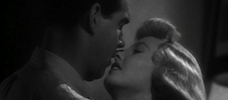Reviews
Roy Rowland
USA, 1953
Credits
Review by Cullen Gallagher
Posted on 15 April 2010
Source Warner Archives DVD
Categories A Criminal Couple
The third pairing of Barbara Stanwyck and Fred MacMurray1 finds the duo in the midst of a messy, 3-D oater written by Niven Busch, whose novel The Furies had been adapted into the 1950 film also starring Stanwyck, a far superior film than this dusty reunion proves to be. Problems arise as soon as the credits finish rolling, with MacMurray reprising his hardboiled sneer for a voice-over narration that reminds of Double Indemnity but with none of the pulpy bite. He is in jail for “moonlighting,” that is, roping and stealing cattle by moonlight. While the crime wins the respect of many for the necessary lassoing skills, it angers even more. As he calmly chain-smokes on his bed, a lynch mob gathers outside his cell intent on putting a noose around his neck.
When the sheriff sneaks away, the mob breaks into the jail. Amidst confusion, the wrong man is lynched. MacMurray gets away and vows retribution against all lynch mobs. A short montage of nighttime attacks lit by blazing fires promises a stylistic and violent revenge fantasy. Unfortunately, this is short lived, as the story takes the first of many digressions which amount to shooting itself in the foot. Here the narrative switches to Stanwyck, MacMurray’s straight-laced former fiancée, who visits a funeral parlor in search of the presumably deceased MacMuarry. A mortician’s flashback (showing MacMurray coming to town, arranging a funeral for the man who was mistakenly lynched, and robbing the locals at gunpoint to pay for the services) proves to her that her ex-lover is, as she suspected, still alive.
It took nearly 20 minutes into this 77-minute feature for Stanwyck to make her first appearance. Were it not for the clumsy flashback, it probably would have taken even longer. If that wasn’t bad enough, it takes half the movie before Stanwyck and MacMurray even begin to spend any one-on-one screen time together—and a pleasant reunion it certainly isn’t. In a soapy twist to this horse opera, MacMurray returns home to find Stanwyck engaged to his brother, a recently fired bank clerk who wants to get revenge by helping MacMurray and his partner (played by Ward Bond) plan a robbery. (Whatever happened to MacMurray’s moralistic crusade? We’ll never know…) While Stanwyck and MacMurray’s barnyard tête-à-tête may be more suited to the hardboiled genre than the Western, it is a welcome reprieve from an otherwise dull picture, and a reminder of the fiery chemistry the two stars shared in three far better movies. In between various slaps and kisses, MacMurray says, “You’re worse than that cat I killed up in the hills,” to which Stanwyck retorts, “Much worse. Only the cat was running away, but I’m not running.”
Adding yet another revenge plotline to the mix, a recently deputized Stanwyck vows to track down MacMurray and Bond after their robbery and bring them back to justice, dead or alive. A gun-toting Stanwyck on horseback improves the picture considerably—probably because she enjoyed these scenes the most, as she fought for the right to be able to do her own stunts. According to director Roy Rowland, “She was capable of doing her own stunt work and completely unafraid. She always wanted to do her stunts, but we could not risk the possibility of an accident. Barbara understood this, but she still pleaded.” And, eventually, she got her way. Whether this was for the picture’s own benefit, however, is debatable, as during a tumble down a waterfall Stanwyck’s extra padding is so noticeable that it takes away from the would-be marvel of the stunt. Still, this is hardly the worst of the picture’s many demerits. 2
Despite whatever expectations the shared billing of Stanwyck and MacMurray may suggest, the climax of the movie is a mountaintop showdown between Stanwyck and Ward Bond. Hiding behind rocks, the two quietly stalk one another in between pot shots and ricocheting bullets. It is a skillfully executed and highly suspenseful scene—and it is also short lived. Those expecting a sex-and-violent charged collision à la Double Indemnity will be, once again, disappointed by The Moonlighter. Instead, what the film offers is one of those improbably happy resolutions that Hollywood excels in concocting, in which good intentions wipe clean the characters’ slates, forgoing the need to actually bring the story to any logical closure. But, with a script as asinine as Niven Busch’s, I’m not sure that any closure could actually improve the movie. Certainly, the 3-D didn’t—original reviewers like Theresa Loeb Cone wondered “why Warner Brothers didn’t make this one in the good old-fashioned 2-D manner,” while Orval Hopkins praised a broken projector that doubled the image “like an insistent conscience… easily the most entertaining part of the program.” 3 Since the DVD of the movie is only available in a 2-D version, I can’t refute either reviewer, but the lackluster nature of the visuals makes me think they were probably right. This is yet another reason why we must be thankful that The Moonlighter is only 77 minutes and not a second longer.
- The role was originally intended for Robert Ryan. Edwin Schallert. “New ‘Poor Butterfly’ Feted in Film; Quinn Gives ‘Quixote’ Impetus.” Los Angeles Times. 19 Feb. 1953.↩
- Sandra Schackel. “Barbara Stanwyck: Uncommon Heroine.” California History, Vol. 72, No. 1 (Spring 1993). 46.↩
- Theresa Loeb Cone. “‘Moonlighter’ Offers some Fancy Scenery.” Oakland Tribune. 8 Oct. 1953. Orval Hopkins. “Stanwyck and MacMurray In a New Three-D Duster.” The Washington Post. 25 Sept. 1953.↩
More A Criminal Couple
We don’t do comments anymore, but you may contact us here or find us on Twitter or Facebook.







